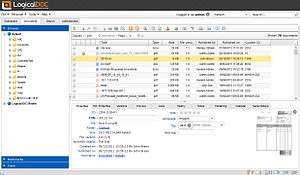LogicalDOC
 | |
|
LogicalDOC - documents browser | |
| Developer(s) | LogicalDOC Srl |
|---|---|
| Stable release |
7.5.4 [1]
/ 8 November 2016 |
| Written in | Java, AJAX enabled |
| Operating system | Cross-platform |
| Available in | Multiple languages |
| Type | ECM, Document Management System, Groupware, Content Management Systems, Open Source |
| License |
Commercial Edition - Proprietary Community Edition - LGPL |
| Website | www.logicaldoc.com |
LogicalDOC is a free document management system that is designed to handle and share documents within an organization.
LogicalDOC is a content repository, with Lucene indexing, Activiti workflow, and a set of automatic import procedures. The system was developed using Java technology.
History
In 2006 two developers with experience in commercial J2EE products decided to start a business called Logical Objects, with the mission to maintain and evolve the Open Source project Contineo.[2] After one year, Logical Objects decided to branch the old project and to start a completely new product called LogicalDOC.
In mid-2008, the first release of LogicalDOC was made available at SourceForge.[3] The first release was numbered 3.6[4] in order to continue the numeration from the old project.
In the 2010 LogicalDOC won the Infoworld Bossie Awards[5] in category: best open source applications.
In the 2015 Logical Objects changed its business name to LogicalDOC, the same name of the product.
In the 2016 LogicalDOC won the CMS Critic Awards[6] in category: Best Document Management System.
License
LogicalDOC source code is distributed under GNU LGPLv3.[7]
Usage
LogicalDOC is a web-based document management application, so a web browser is needed to use it. Current web browsers that have been tested for compatibility with Logical Doc include: Firefox, Internet Explorer, Safari, Google Chrome. The web interface is built using Google Web Toolkit.
Architecture
LogicalDOC is developed using Java technology based on J2SE standards and the Tomcat application server. Therefore, it can be installed and executed on various platforms (Linux, Windows, Mac OS X)
The LogicalDOC architecture is based on the following technologies:
- Apache Tomcat Application Server
- Java J2SE
- GWT (Google Web Toolkit - Ajax)
- Lucene
- Spring Framework
Due to its lightweight architecture, LogicalDOC can work on a wide set of devices and can be used to implement Cloud/SaaS document management.
Data can be stored in a RDBMS (MySQL, Oracle, Microsoft SQL Server, PostgreSQL, etc.)
General features
A document management system manages personal documents or business documentation, making it easier to find a previous document version. It enables searching by content, using document content indexing. LogicalDOC has currently been localized in 15 languages. LogicalDOC can be set up to support distinct full-text indexes for each supported language in order to apply specific indexing algorithms tailored to a particular language or variant.
- Document Management
- Document revisioning (minor and major revisions)
- Image Management
- Repository access via WebDAV and Web API
- Activiti workflow
- Lucene search
- Multi-language support
- Multi-platform support (Windows, Linux, Mac OS X)
- Browser-based GUI (Internet Explorer, Firefox, Google Chrome, Safari)
- Desktop integration with Microsoft Office and Microsoft Outlook
- Pluggable authentication: LDAP or Active Directory
- Multiple Database support: MySQL, PostgreSQL, Oracle, Microsoft SQL Server
- Documents full preview
- Integrated OCR and Barcode recognition
- Integrated TWAIN scanner support
- Clustering support
Awards
- Infoworld Bossie Awards 2010 in category: best open source applications.
- CMS Critic Awards 2016 in category: Best Document Management System.
See also
References
- ↑ "Release notes for LogicalDOC 7.5". http://wiki.logicaldoc.com/. LogicalDOC. 10 February 2016. Retrieved 10 February 2016. External link in
|website=(help) - ↑ "Contineo". sourceforge. Retrieved 31 October 2013.
- ↑ "LogicalDOC Document Management - DMS". sourceforge. Retrieved 31 May 2013.
- ↑ Gasparini, Alessandro (20 October 2008). "LogicalDOC - Document Management, DMS version 3.6 released". TheServerSide. TechTarget. Retrieved 31 October 2013.
- ↑ Binstock, Andrew; Dineley, Doug; Borck, James R.; Heller, Martin; Mobley, High (25 August 2010). "Bossie Awards 2010: The best open source applications". Infoworld. Retrieved 31 October 2013.
- ↑ "CMS Critic Awards 2016: The best document management system". CMS Critic.
- ↑ "The GNU Lesser General Public License, version 3.0 (LGPL-3.0)". Open Source Initiative. 29 June 2007. Retrieved 31 October 2013.
